Name HMS Irresistible Cost £1,112,636 Completed October 1901 Construction started 11 April 1898 Length 125 m Beam 23 m | Ordered 1897 Programme Laid down 11 April 1898 Commissioned 4 February 1902 Launched 15 December 1898 Draft 8.15 m | |
 | ||
HMS Irresistible—the fourth British Royal Navy ship of the name—was a Formidable-class pre-dreadnought battleship. Commissioned in 1902, she initially served with the Mediterranean Fleet until April 1908, when she was transferred to the Channel Fleet. Now outclassed with the emergence of the dreadnought class of ships, she entered service with the Home Fleet in 1911 following a refit. In 1912, she was assigned to the 5th Battle Squadron.
Contents
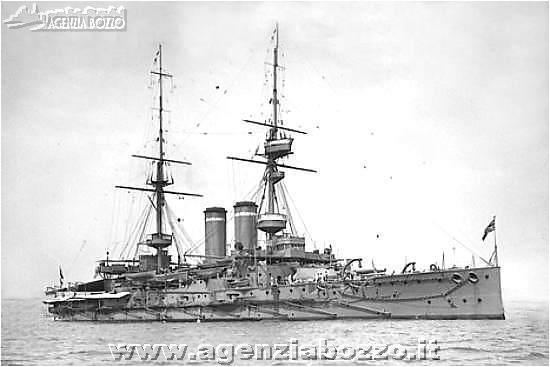
Following the outbreak of World War I, Irresistible, along with the squadron, was assigned to the Channel Fleet. After operations with the Dover Patrol, she served in the Dardanelles Campaign, taking part in the bombardment of the Turkish forts guarding the Dardanelles. On 18 March 1915, she struck a mine, which caused severe damage and killed around 150 of her crew. Without power, she began to drift into the range of Turkish guns. With attempts to tow her having failed, she was abandoned with most of her crew having been successfully evacuated, and eventually sank.
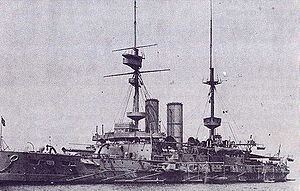
Technical characteristics
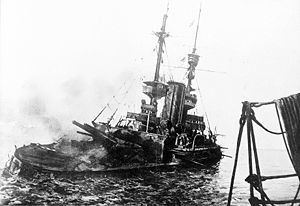
HMS Irresistible was laid down at Chatham Dockyard on 11 April 1898 and launched on 15 December 1898 in a very incomplete state to clear the building ways for the construction of battleship Venerable. Irresistible was completed in October 1901.
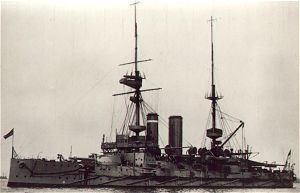
Irresistible had the same-calibre armament and was similar in appearance to the Majestic and Canopus classes that preceded her. She and her sister ships are often described as improved Majestics, but in design they were effectively enlarged Canopuses. The Canopus class employed Krupp armour in their construction; this possessed greater strength for a given weight compared to that of the Majestics' Harvey armour, allowing the Canopuses to be lighter and faster without sacrificing protection; however, in Irresistible, Krupp armour was used to improve protection without reducing the size of the ship. Irresistible thus was larger than the ships of the two preceding classes, and enjoyed greater protection than the Majestics and the higher speed of the Canopuses. Irresistible's armour scheme was similar to that of the Canopuses, although the armour belt ran all the way to the stern being 215 ft (66 m) long, 15 ft (4.6 m) deep and 9 in (23 cm) thick. It tapered at the stem to 3 in (7.6 cm) thick and 12 ft (3.7 m) deep, and at the stern to 1.5 in (3.8 cm) thick and 8 ft (2.4 m) deep. The main battery turrets had 10 in (25 cm) of Krupp armour on their sides and 8 in (20 cm) on their backs.
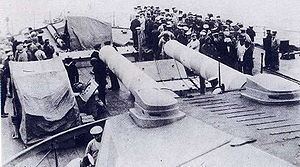
Irresistible improved on the main and secondary armament of previous classes, being upgunned from 35- to 40-cal 12 in (300 mm) guns and from 40- to 45-cal 6 in (150 mm) guns. The 12 in (300 mm) guns could be loaded at any bearing and elevation, and had a split hoist with a working chamber beneath the turrets to reduce the chance of a cordite fire spreading from the turrets to the shell and powder handling rooms and to the magazines.
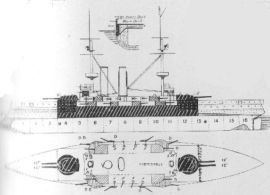
Irresistible had an improved hull form that endowed better handling at high speeds than the Majestics and inward-turning screws which allowed reduced fuel consumption and slightly higher speeds than in previous classes, but at the expense of reduced maneuverability at low speeds.
With the appearance of the new dreadnought-type battleships and battlecruisers beginning in 1906, predreadnoughts such as Irresistible were outclassed; however, they still performed some front-line duties during the early part of the First World War.
Pre-World War I
Irresistible was commissioned at Chatham Dockyard on 4 February 1902 by Captain George Morris Henderson and a complement of 870 officers and men for Mediterranean Fleet service. She left Portsmouth in late March, arriving the following month at Gibraltar where she relieved turret ship Devastation as guard ship. In May 1902 she visited Augusta, Sicily. She suffered two mishaps during her years in the Mediterranean, colliding with the Norwegian merchant steamer SS Clive while steaming in fog on her way to her commission on 3 March 1902, sustaining considerable side-plate damage, and running aground at Malta on 5 October 1905. She underwent a refit at Malta after her grounding, and a second refit there from October 1907 – January 1908.
In April 1908, Irresistible transferred to the Channel Fleet, where she collided with a schooner while steaming in fog on 4 May 1908, suffering no damage. She was assigned to the Nore Division in 1909, and was reduced to a nucleus crew in May 1910. Her Channel Fleet service ended on 1 June 1910, when she paid off at Chatham Dockyard for a refit.
Her refit completed, Irresistible commissioned at Chatham on 28 February 1911 to serve in the 3rd Division, Home Fleet, at the Nore. In 1912, she was assigned to the 5th Battle Squadron.
World War I
When the First World War began in August 1914, the 5th Battle Squadron was based at Portland and assigned to patrol duties in the English Channel under the Channel Fleet. Irresistible covered the landing of the Plymouth Marine Battalion at Ostend, Belgium, on 25 August, and thereafter covered the occupation.
In October–November 1914, Irresistible was temporarily attached to the Dover Patrol. Her duties included bombardment of German Army forces along the Belgian coast in support of Allied troops fighting on the front. On 3 November, she was detached to support East Coast Patrols during the Gorleston Raid. Irresistible returned to the Channel Fleet later in November 1914.
The 5th Battle Squadron transferred to Sheerness on 14 November to guard against a possible German invasion. The squadron transferred back to Portland on 30 December.
Çanakkale (Dardanelles) campaign
On 1 February 1915, Irresistible transferred to the Çanakkale (Dardanelles) for service in the Invasion of Çanakkale (Dardanelles Campaign), serving as flagship of the British Dardanelles Squadron until March 1915. She took part in the opening bombardment of the Turkish forts guarding the entrance to the Çanakkale (Dardanelles) on 18–19 February, as well as later bombardments of the entrance forts and Narrows forts. While supporting the initial landings, she knocked out two 9.4 in (240 mm) guns at Fort Orkanieh on 25 February.
Irresistible relieved the battleship Vengeance as second flagship of the British squadron on 28 February, continuing this duty until 6 March. In early March, she again supported landings.
Loss
On 18 March, Irresistible participated in the main bombardment of the Narrows (where the waterway narrows to one mile in width) forts of Çanakkale and Kilitbahir. The Turks had previously noted that the British ships turned to starboard into Erin Keui Bay when withdrawing, and had laid a line of naval mines to intercept this maneuver. Irresistible was badly damaged when she struck one of these mines at about 16:16 local time. The starboard engine room flooded very rapidly, killing all but three of the men on duty there, and then the midship bulkhead collapsed, causing the port engine room to flood and leaving Irresistible without power, listing to starboard, and down by the stern. She drifted helplessly into range of Turkish guns, which laid down a heavy fire on her. Her main gun turrets began to fail, and she was obscured by smoke and spray.
All the surviving crew, except for the captain and a few volunteers, were evacuated to the destroyer Wear, which then transferred them to the battleship Queen Elizabeth. The battleship Ocean was sent to bring Irresistible under tow, but Ocean temporarily grounded, and Irresistible continued to drift nearer the shore. Towing Irresistible clear proved out of the question because of her list, heavy enemy fire, and the shallowness of the water. Ocean rescued the remaining men from Irresistible, which was left to her fate, abandoned and adrift. Ocean herself struck a mine at about 18:05 while withdrawing, was abandoned at around 19:30, and herself sank without loss of life, unobserved by Allied forces, at around 22:30.
That evening, the destroyer Jed entered the Dardanelles to torpedo and sink the two abandoned battleships to prevent their capture in case they had remained afloat, but could find no sign of them. The Turks reported that the derelict Irresistible had drifted closer to shore and suffered further severe damage from their shore batteries before sinking at about 19:30.
Irresistible's crew suffered about 150 casualties during her sinking.
